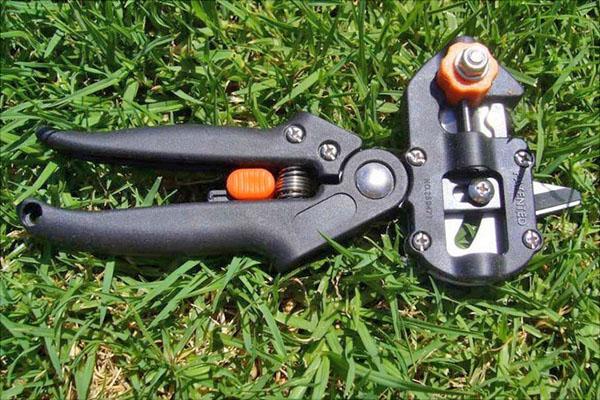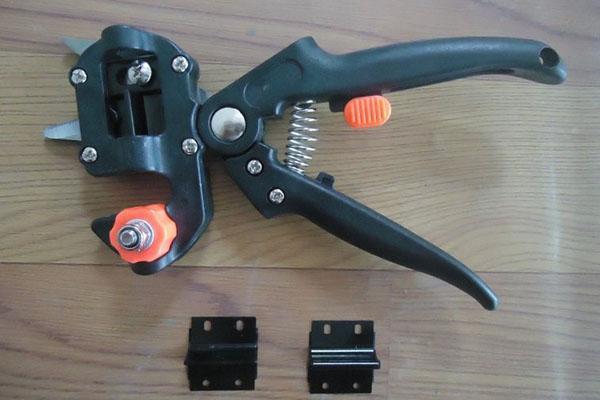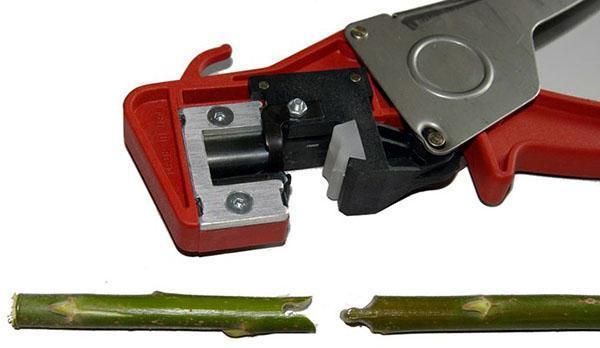Vaccination pruner - a godsend for an inexperienced hobbyist
 Successful grafting requires a steady hand, a good eye, dexterity and a sharpened knife. The grafting pruner is useful for the novice gardener and professional. Each tool has advantages and disadvantages. A tool in the wrong hands will be useless if you do not fulfill the basic requirements of the correct budding.
Successful grafting requires a steady hand, a good eye, dexterity and a sharpened knife. The grafting pruner is useful for the novice gardener and professional. Each tool has advantages and disadvantages. A tool in the wrong hands will be useless if you do not fulfill the basic requirements of the correct budding.
Pruner device for grafting

If the grafting is carried out on an annual seedling, removing the stem, the rootstock is fixed on top. When planting a seedling, you need to grab the stock so as not to pull out the fragile scion from the nest. An omega cut at the junction gives the best results, but is not suitable for working with dense tree species.
Based on the described process, it is clear that in order to make an accurate straight cut without squeezing over a large area, special steel is needed. Therefore, the quality of the instrument depends on:
- from the materials used for the manufacture of the cutting part of the grafting secateurs;
- method of manufacturing and joining parts:
- obtaining the cutting surface and its thickness.
High-carbon steels are considered the best, with the manufacture of parts forged or riveted. Forged products have special strength, but they also significantly increase the cost of the process.
 The cutters at the moment of exposure create a figured cut of one profile, so the scion and rootstock are ideally combined if the rods are of the same cross section. Watch the video of how the grafting pruner works, and everything will become clear.
The cutters at the moment of exposure create a figured cut of one profile, so the scion and rootstock are ideally combined if the rods are of the same cross section. Watch the video of how the grafting pruner works, and everything will become clear.
What attracts a new tool for a gardener and an amateur:
- Guaranteed coincidence of two rootstock and scion cuts.
- No adjustments are required, the cut is clean, made quickly, which means that, subject to hygiene, the cutting will take root.
- With a high speed of operations performed, a professional will do more work in a day.
The disadvantage is the very high cost of a quality tool. Pruner price for grafting trees the best manufacturers are approaching a hundred thousand rubles. This is what determines why there are so many homemade devices that work effectively.
A high-quality grafting cannot be performed if the difference in the thickness of the scion and rootstock exceeds 3 mm.
Contrary to the stated parameters, the grafting pruner rarely makes a high-quality cut with a branch thickness of more than 10 mm.
Why Buy a Professional Grafting Tool
 This professional tree grafting tool is considered the benchmark for quality. Made of the best tool steel, by forging the blade, the knife does not dull as it goes into dense wood in oil.With the help of very thin forged V-shaped, U-shaped and Omega-shaped blades, it is possible to make shaped cuts with shears for grafting trees and shrubs. The gardener decides which knife to use, depending on the density of the wood. The nozzles are changed at the same time. They are double-edged and can withstand up to 3000 cuts. The tool has a 3 year warranty that does not cover consumables.
This professional tree grafting tool is considered the benchmark for quality. Made of the best tool steel, by forging the blade, the knife does not dull as it goes into dense wood in oil.With the help of very thin forged V-shaped, U-shaped and Omega-shaped blades, it is possible to make shaped cuts with shears for grafting trees and shrubs. The gardener decides which knife to use, depending on the density of the wood. The nozzles are changed at the same time. They are double-edged and can withstand up to 3000 cuts. The tool has a 3 year warranty that does not cover consumables.
No less high quality and all other parts made of reinforced plastic and high quality steel. A special tool is required to sharpen knives, but there is no need for sharpening:
- each side of the blade can withstand at least 3000 cuts, and there are 2 of them on each nozzle;
- there are three attachments included with the professional grafting tool;
- the store always has replaceable attachments that are not expensive.
 There is an alternative to an expensive tool. Chinese and Belarusian manufacturers offer their products at a price several times lower than an Italian instrument. Chinese models are good only for the first cuts. They bite easily into thin, fresh wood. With the manufacturer's declared ability to work with grafting material with a cross-section of 13 mm, they become blunt at the very first cuts, and later disintegrate from the applied efforts.
There is an alternative to an expensive tool. Chinese and Belarusian manufacturers offer their products at a price several times lower than an Italian instrument. Chinese models are good only for the first cuts. They bite easily into thin, fresh wood. With the manufacturer's declared ability to work with grafting material with a cross-section of 13 mm, they become blunt at the very first cuts, and later disintegrate from the applied efforts.
The new grafting pruner tool was patented in 1983 in the USSR. Invented by scientists Kostrikin I.A. and Melnichenko NI, first for vineyards, and in 1992 for fruit and ornamental plants. The purpose of the invention was to facilitate the manual labor of the peasants.
Belarusian grafting secateurs are made using tool steel for knives and steel 20 for holders and a handle, making them stronger. Silicone onlays give aesthetics. Zinc coating prevents corrosion of metal parts. Belarusian knives are of high quality, since the cutting part is forged, just like in Italian products. Such a grafting pruner costs 1,600 rubles, and is available to villagers with low incomes.
Making grafting secateurs yourself
 Having got acquainted with the device and the principle of operation of the proprietary tools developed by the designers, the craftsmen adopted the shape of knives and created their own tools.
Having got acquainted with the device and the principle of operation of the proprietary tools developed by the designers, the craftsmen adopted the shape of knives and created their own tools.
In order for the knives to enter the soft tissue of the branches without injuring them, it requires the transfer of large forces by a lever or a screw and a knife created for its design. Garlic and small yews are used. Craftsmen do not even need drawings to make a grafting pruner with their own hands. Homemade tools are used by professionals and deserve flattering reviews.